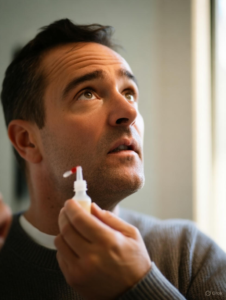How Should Eye Examination Be Done in Children and Teenagers?
Good vision is essential for a child’s learning, development, and daily life. Any uncorrected visual problem may affect school performance and quality of life.
That’s why an eye examination for children and young patients should be done carefully, step by step — not only to detect refractive errors but also to rule out eye diseases like keratoconus.
At Kaşkaloğlu Eye Hospital, every young patient is examined with advanced diagnostic methods to ensure accurate diagnosis and the most suitable treatment.
1. Measuring Vision Without Glasses
The first step is to measure visual acuity without glasses.
This helps the doctor see how well the patient can read and see distant and near objects naturally.
If the vision is blurred, the cause may be myopia (nearsightedness), hypermetropia (farsightedness), or astigmatism.
2. Corneal Topography for Keratoconus Screening
Every child or young patient should undergo corneal topography.
This test maps the surface of the cornea and helps detect keratoconus — a condition where the cornea becomes thinner and cone-shaped over time.
Keratoconus often begins as myopia or astigmatism and can easily be missed in busy clinics if detailed testing is not done.
Early diagnosis is extremely important because untreated keratoconus can lead to permanent vision loss.
3. Eye Drops to Determine the Real Prescription
In children, the focusing muscles are very active.
For this reason, measurements taken without drops may be misleading.
To determine the true refractive power, the eyes are dilated with special drops and measurements are repeated — this is called a cycloplegic refraction test.
It helps the ophthalmologist detect hidden hypermetropia or other refractive errors that are not visible during routine measurement.
4. Different Approach for Myopia and Hypermetropia
Every case is unique, and treatment depends on the type of refractive error.
Hypermetropia (Farsightedness)
If the child has hypermetropia but no strabismus (eye deviation), glasses may not always be prescribed immediately.
The doctor may decide based on the degree of hypermetropia and keep the child under follow-up.
Myopia (Nearsightedness)
In myopia, after keratoconus is ruled out, glasses are prescribed.
Families are informed about options that slow down the progression of myopia, such as special lenses (like MyoSmart) or special contact lenses.
5. Measuring Axial Length for Objective Follow-Up
At Kaşkaloğlu Eye Hospital, the axial length of the eye (the front-to-back distance) is measured in addition to refraction.
This allows doctors to objectively monitor whether the eye is growing — which means myopia is progressing.
Families receive clear, data-based feedback about their child’s eye development during each visit.
6. Informing the Family and Regular Check-ups
Parents are often concerned about myopia progression.
That’s why every examination includes detailed counselling — explaining the results, treatment plan, and follow-up schedule.
With regular check-ups, vision can be kept under control and long-term eye health can be protected.
Comprehensive Pediatric Eye Examination at Kaşkaloğlu Eye Hospital
At Kaşkaloğlu Eye Hospital, children and teenagers are examined with the latest diagnostic technology — including corneal topography, cycloplegic refraction, and axial length measurement.
Our experienced ophthalmologists provide customized treatment plans to ensure the best visual outcomes and peace of mind for families.
SEO Keywords:
child eye examination, pediatric ophthalmology, keratoconus screening, myopia control, MyoSmart lenses, eye drops refraction, axial length measurement, Kaşkaloğlu Eye Hospital, Izmir eye doctor
Meta Title:
Eye Examination for Children and Teenagers | Kaşkaloğlu Eye Hospital Izmir
Meta Description:
Learn how children’s eye examinations are performed at Kaşkaloğlu Eye Hospital — including keratoconus screening, dilated refraction, and axial length measurement for myopia control.
İstersen şimdi bu yazı için featured image ve alt text önerilerini (SEO’ya uygun biçimde) de hazırlayayım mı?














